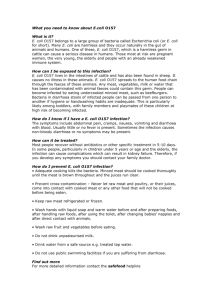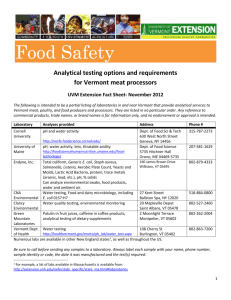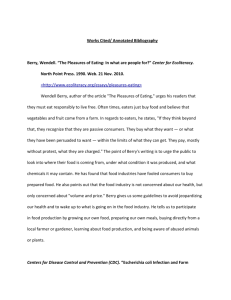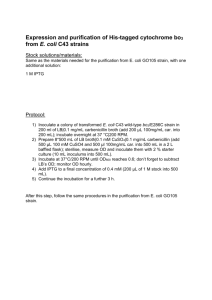The Refrigeration Index Calculator Explanation
advertisement
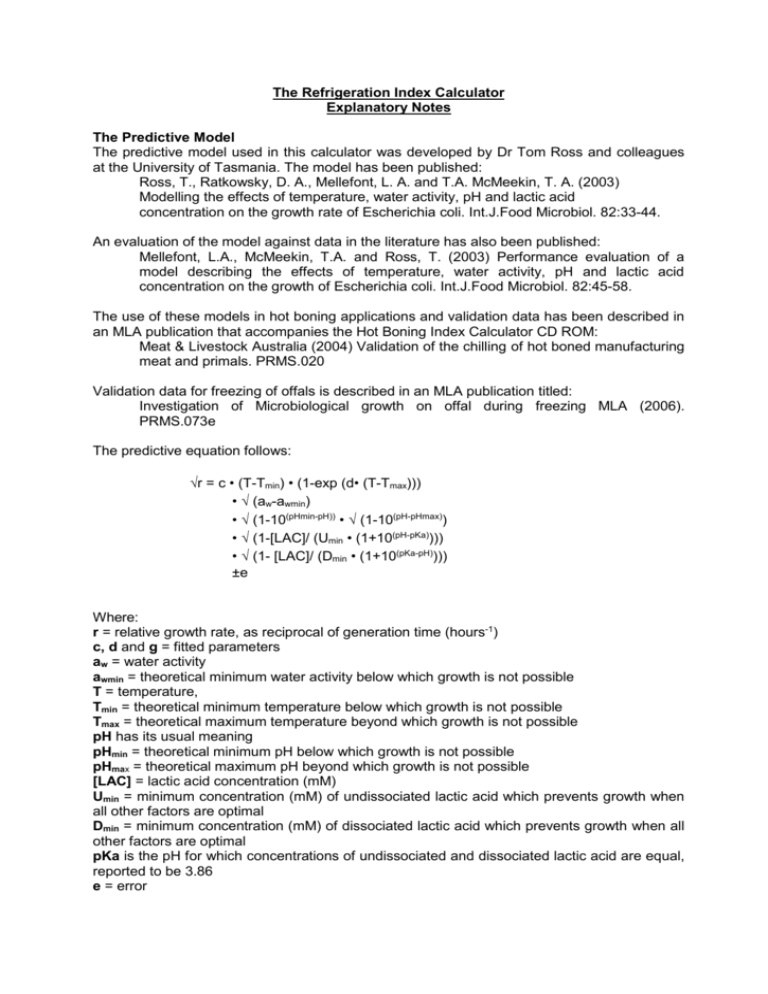
The Refrigeration Index Calculator Explanatory Notes The Predictive Model The predictive model used in this calculator was developed by Dr Tom Ross and colleagues at the University of Tasmania. The model has been published: Ross, T., Ratkowsky, D. A., Mellefont, L. A. and T.A. McMeekin, T. A. (2003) Modelling the effects of temperature, water activity, pH and lactic acid concentration on the growth rate of Escherichia coli. Int.J.Food Microbiol. 82:33-44. An evaluation of the model against data in the literature has also been published: Mellefont, L.A., McMeekin, T.A. and Ross, T. (2003) Performance evaluation of a model describing the effects of temperature, water activity, pH and lactic acid concentration on the growth of Escherichia coli. Int.J.Food Microbiol. 82:45-58. The use of these models in hot boning applications and validation data has been described in an MLA publication that accompanies the Hot Boning Index Calculator CD ROM: Meat & Livestock Australia (2004) Validation of the chilling of hot boned manufacturing meat and primals. PRMS.020 Validation data for freezing of offals is described in an MLA publication titled: Investigation of Microbiological growth on offal during freezing MLA (2006). PRMS.073e The predictive equation follows: √r = c • (T-Tmin) • (1-exp (d• (T-Tmax))) • √ (aw-awmin) • √ (1-10(pHmin-pH)) • √ (1-10(pH-pHmax)) • √ (1-[LAC]/ (Umin • (1+10(pH-pKa)))) • √ (1- [LAC]/ (Dmin • (1+10(pKa-pH)))) ±e Where: r = relative growth rate, as reciprocal of generation time (hours-1) c, d and g = fitted parameters aw = water activity awmin = theoretical minimum water activity below which growth is not possible T = temperature, Tmin = theoretical minimum temperature below which growth is not possible Tmax = theoretical maximum temperature beyond which growth is not possible pH has its usual meaning pHmin = theoretical minimum pH below which growth is not possible pHmax = theoretical maximum pH beyond which growth is not possible [LAC] = lactic acid concentration (mM) Umin = minimum concentration (mM) of undissociated lactic acid which prevents growth when all other factors are optimal Dmin = minimum concentration (mM) of dissociated lactic acid which prevents growth when all other factors are optimal pKa is the pH for which concentrations of undissociated and dissociated lactic acid are equal, reported to be 3.86 e = error The values of the constants are: Parameter C T min T max pH min pH max U min D min aw min d Root Mean Square Error (RMSE) in √(1/(GT [h])) Estimate 0.2790 4.14 49.55 3.909 8.860 10.43 995.5 0.9508 0.2636 0.0054 Model parameters for each product type The RI Calculator allows the selection of a number of products. The parameters associated with each product types are indicated in the table below: Carcase Boxed trim Lean Primal Fat Primal Offal Mechanically separated meat pH 6.5 6.5 5.4 6.8 6.8 6.8 Lactate(mM) 51.7 51.7 86.5 0 25 51 aw 0.993 0.993 0.993 0.990 0.995 0.995 Lag phase A lag phase may occur when a bacterium moves from one environment to another, especially if it has to adjust to a new environment. The hot boning work described above demonstrated a good correlation when 5 generations of lag were introduced to the equation. 5 generations of growth (1.5 log10) can be subtracted from the calculated refrigeration index in situations where a lag may occur. The question ‘the starting temperature is hot’ determines whether a lag is applied. If the meat is hot or warm, then it is assumed that E. coli has recently been introduced to the meat surface and a 5 generation lag is allowed. If the meat is cold, then it is assumed that E. coli may already be present on the meat, has adjusted to the environment and is ready to grow as soon as the temperature rises. Temperature Temperature is the only parameter that can be entered by the user. Data may be entered manually, or cut and pasted from spreadsheets etc. Time For the calculation of the RI it is necessary to know the time interval between temperature measurements. The time interval needs to be constant through each set of data. Calculation of the Refrigeration Index The Refrigeration Index is the sum of E. coli growth under changing temperatures over the time taken for the meat to cool to less than 7°C. Thus, the growth of E. coli is calculated over small time intervals where the temperature is assumed to be effectively constant, and then the growth in all of the time intervals are added together. The RI indicates how many E. coli (actually expressed as log10 E. coli numbers) would result if one cell was initially on the meat. Over a small time interval, t=0 to t=t, the number (N) of E. coli will increase according to the following equation: log10Nt – log10N0 = (t-t0) x r x 0.30103 r is the relative growth rate from the predictive equation. The RI is simply the sum of (log10Nt – log10N0) for all of the time intervals for which temperature readings are available. Future Development As the industry gains experience with the RI Calculator, it is likely that modifications will be made to the way that the calculator functions. There may also be scientific advances that cause the basic calculations and parameters to be changed. Additional validation studies may suggest new parameters. Studies on carcase chilling, in which pH, aw and temperature vary during the process may suggest new ways to utilize the power of the predictive model for monitoring the hygiene of meat processing.
